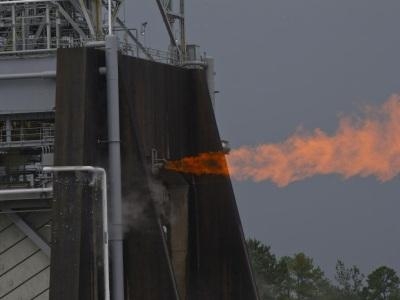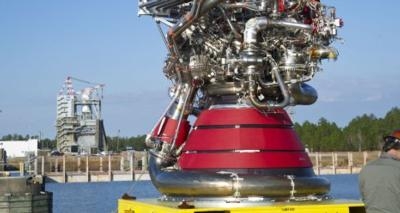Fri, Apr 26, 2013
Pratt & Whitney Rocketdyne Completes J-2X Hot Fire Testing
The last in a series of hot-fire tests on a J-2X engine with a stub-nozzle extension at simulated altitude conditions has been completed by Pratt &Whitney Rocketdyne. This latest chapter in the development of America's next rocket engine paves the way toward full-motion testing of the J-2X engine, which is designed to power humans to Mars. NASA has selected the J-2X as the upper-stage propulsion for the evolved 143-ton Space Launch System (SLS), an advanced heavy-lift launch vehicle.

"This test series with the stub-nozzle extension was very successful," said Walt Janowski, J-2X program manager, Pratt & Whitney Rocketdyne. "We completed all the objectives we set out to accomplish, and acquired important information to help us better understand how the engine will perform during flight – from thrust, hardware durability and combustion stability. We look forward to continuing to work with NASA to provide a safe, reliable transportation system to explore new destinations in space."
In the latest series of tests with the stub-nozzle extension, J-2X Engine 10002 was tested six times for a total of 2,156 seconds on the A-2 test stand at John C. Stennis Space Center in Mississippi. The stub-nozzle extension allows engineers to test the engine in near-vacuum conditions, similar to what it will experience in the extreme environment of space. The next step is to move the engine to the A-1 test stand, where it will be fired to test the range of gimbal motion for its flexible parts. Engine 10002 is the second J-2X development engine built by Pratt & Whitney Rocketdyne for NASA.
The first J-2X engine, Engine 10001, was tested a total of 21 times for more than 45 minutes last year. The J-2X powerpack, which consists of components on top of the engine, was tested separately 13 times for a total of more than 100 minutes at Stennis Space Center. The engines and powerpack were fired at varying pressures, temperatures and flow rates to ensure the engine is ready to support exploration beyond low-Earth orbit, Mars and beyond.
(Images provided by NASA)

More News
With Testing Soon Complete, Launch Preparations Begin in Earnest Sierra Space's Dream Chaser has been put through the wringer at NASA's Glenn Armstrong Test Facility in Ohio, but w>[...]
Takeoff Roll The process whereby an aircraft is aligned with the runway centerline and the aircraft is moving with the intent to take off. For helicopters, this pertains to the act>[...]
“We’re proud of the hard work that went into receiving this validation, and it will be a welcome relief to our customers in the European Union. We couldn’t be mor>[...]
"Aircraft Spruce is pleased to announce the acquisition of the parts distribution operations of Wag-Aero. Wag-Aero was founded in the 1960’s by Dick and Bobbie Wagner in the >[...]
IDENT Feature The special feature in the Air Traffic Control Radar Beacon System (ATCRBS) equipment. It is used to immediately distinguish one displayed beacon target from other be>[...]
 Sierra Space Repositions Dream Chaser for First Mission
Sierra Space Repositions Dream Chaser for First Mission ANN's Daily Aero-Term (05.10.24): Takeoff Roll
ANN's Daily Aero-Term (05.10.24): Takeoff Roll Aero-News: Quote of the Day (05.10.24)
Aero-News: Quote of the Day (05.10.24) Aero-News: Quote of the Day (05.11.24)
Aero-News: Quote of the Day (05.11.24) ANN's Daily Aero-Term (05.11.24): IDENT Feature
ANN's Daily Aero-Term (05.11.24): IDENT Feature




